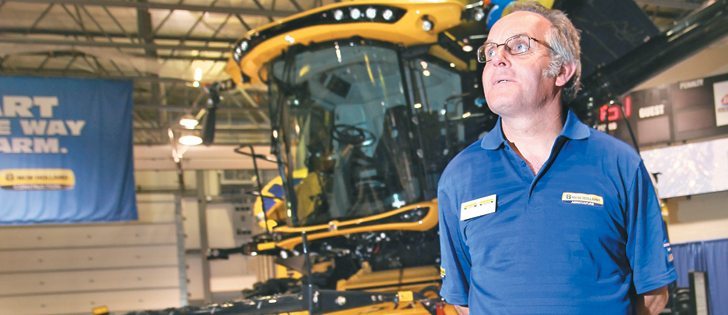New Holland takes step up | Company celebrates 40th anniversary with new twin rotor machine harnessing 653 h.p.
REGINA — Three years of development yielded one of the largest combines in the world and just in time for the 40th anniversary of New Holland’s twin rotor machines.
“It was a lot more than turning up the power on the engine,” said Nigel Mackenzie of New Holland.
He was on hand in Regina for Canada’s Farm Progress Show and the international debut the New Holland’s first Class 10 combine.
And while it does share a frame, threshing area and rotor design with its Class 8, 9 siblings, the addition of a large, horizontally mounted, 18 inch beater ahead of the 22 inch rotors adds substantial capacity to the machine.
Read Also

India slaps 30 per cent import duty on yellow peas
India has imposed a 30 per cent duty on yellow pea imports with a bill of lading date on or after Nov. 1, 2025.
Originally designed for rock management in soils where stone intake is unavoidable, the Dynamic Feed Roll was found to be adding more threshing capacity to CR8 and CR9 combines using the option.
That new system was unveiled in Germany at the Agritechnica trade show last fall to provide on-the-go rock removal. Serrated knives on the pre-threshing roller manage lumps and tough crop to create more even threshing inside the concaves.
“It turns out the roll doesn’t use any more power than if you don’t have it, because it has saved the rotors a lot of work,” said Mackenzie.
Other changes include, larger, square rasp bars on the S-cube rotors.
“We are running the rotors more slowly on the new machine and (the concaves) not as tight. It’s easier on the crop and we have the power to keep it moving through. We are getting even better samples and more capacity,” he said about that change.
Getting to a Class 10 does take more power, so the New Holland original Elevation version, the Class 9 machine, moves from 571 h.p. to 653 with an engine change.
The Class 10, CR10.90, needed to be Tier 4B compliant so it got Fiat’s new 16 litre, selective catalytic reduction, common rail engine.
“There’s no (exhaust gas recirculation) on this engine. You have to fill every other day with (diesel exhaust fluid). It does use more DEF, up from three to four percent (of total fluids) to five to seven percent,” he said.
The new T4B engine has added three or four percent to the cost of new CR10.90, which now has a list price of $745,000.
“It won’t be for everybody, but for those who can use it, the capacity pays its own way,” said Mackenzie.















